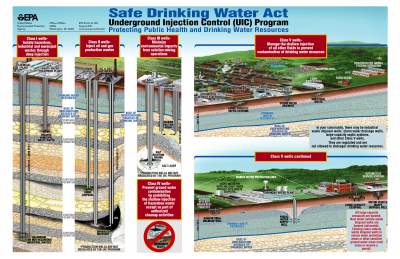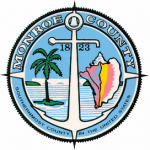Cudjoe Shallow Wells Need Deeper Look

by JD Adler…
Environmental attorneys Caron Balkany and Christopher Byrd have issued a 60 day notice of intent to sue the government on behalf of local fisherman Mike Laudicina, due to failure to acquire proper review for the shallow well injection of municipal sewage in the Cudjoe Key area. They have issued a press release stating that Monroe County and the Florida Keys Aqueduct Authority (FKAA) have utilized a “fake” environmental assessment report to support their contention that this method is safe.
Their concerns spring from evidence that shallow well systems are unable to contain harmful wastewater effluent which could result in damage to the surrounding endangered species, fisheries, and wetlands. They believe that a deep injection well is a safer alternative and is required by state statutes. (For a technical explanation of the difference between the two read this brief created by the City of Key West to educate the public on their decision to install a deep well.)
They are requesting that the project be halted until a full environmental impact assessment is peformed. However, at this time, the four shallow wells intended to service the Cudjoe area have been built and a dye test aimed at determining to what extent contaminated wastewater will reach proteced surface waters has begun. Initial wastewater treatment is expected to begin in May.

In the 60-day notice, the Plaintiff, Mike Laudicina, is described as a resident of Big Pine Key, Florida. “He is a commercial fisherman who regularly harvests crab and lobster from waters around the Plant. He also snorkels, crabs, and fishes the area for recreation. He has lived in Monroe County for over 40 years, and has served on the Florida Keys National Marine Sanctuary Advisory Council for nine years and the Gulf of Mexico Spiny Lobster Advisory Council for many years.” They define the basis of his case as the negative environmental impact of the plant on those commercial and recreational interests in the Cudjoe area.
Assessment?
The document Balkany and Byrd are referring to as “fake” was published in 2010 and bears the logo of the US Army Corps of Engineers, as well as its name prominently throughout. This assessment, which has the word “draft” emblazoned across the first page, is currently on the Monroe County site both independently and as Appendix E of the Cudjoe Regional Wastewater Treatment Facilities Plan (AKA the Shallow Well plan). However, according to the lawyers, their research has determined that the Corps has no record of this assessment having been conducted.
Kirk Zuelch, Executive Director of FKAA and Cynthia Hall, an attorney for Monroe County, claim that the document in question is not fake but a draft generated by the FKAA for the Corps as part of a standard process for requesting federal funding. Since they did not receive those funds, the document was never finalized by the Corps which is why, according to them, the Corps has no record. According to John Campbell, in the media office of the US Army Corps of Engineers, the document was not finalized because the FKAA “chose to go another direction.” When asked if he was concerned about their logo being on this public document they did not author, he said, “My concern is starting to grow.”
When asked why the Corps logo remained without any indication of its original author and whether this could be misleading, Ms. Hall didn’t disagree. She did argue that, as it was a document prepared for the County, they did not have the legal right to alter it. As a result of legal action and continued press inquires, Ms. Hall stated she has been discussing with attorneys from the Corps how the County might generate a cover page for the document that denotes the FKAA authorship.
Ms. Balkany, an attorney living in the Keys who has been investigating this for over a year, stated she never believed it was a falsified document. Rather, her concern is that by keeping the Army Corps of Engineers logo and name on the draft document when submitting it along with other required documents to the Department of Environmental Protection (DEP), and others, it “creates the illusion that a proper assessment was done.” This is the reason she refers to it as a “fake” document. She further believes that the County Commissioners are not aware of the problematic nature of the report or its implications. As she states in her March 13, 2015 letter to the Commissioners:
“Due to mistaken reliance on this purported environmental assessment, the County – including the Commissioners, the County Administrator, and County staff and counsel – is probably unaware of the environmental damage and damage to federally protected endangered species and designated critical habitat that can and will result from the use of the shallow sewage injection wells. Likewise, it seems apparent that the County is not aware that the announced April start-date for the use of the shallow sewage wells — while legal challenges to the permit are still pending — will violate the Florida Administrative Procedures Act, Chapter 120, Florida Statutes and result in further litigation, and that the use of the shallow sewage wells without mandatory compliance with federal environmental laws will subject both the County and FKAA to civil and criminal penalties.”
As Ms. Hall (Monroe County) and John Campbell (Army Corps) both assured me, it is not unusual for a document like this to be created by the applicant (e.g., FKAA) and then edited by the agency ultimately identified as author (e.g. Army Corp). What is unusual, according to Ms. Balkany, is for it to appear in the final draft of the facility plan with the Corps logo and introductory language about the Corps, absent any FKAA identifiers.
There is also a later application for federal RESTORE funding (which they did not receive) that included a reference to this draft document as, “The Draft EA will constitute the Corps’ Biological Assessment and Section 4.6 addresses the affects to threatened and endangered species,” which would appear to suggest they were representing the earlier draft by the FKAA with the Corp logo as an independent study by the Corps. Mr. Campbell would not definitively call it either appropriate or inappropriate, stating only that there were no current projects involving the Corps and the Cudjoe plant. He did point out that the content appeared to be drawn from earlier projects that the Corps had done for other municipalities in the Keys.
Attempts to discuss this document with County Mayor Danny Kolhage and the Monroe County Director of Engineers, Kevin Wilson, resulted in being directed to speak with the Assistant County Attorney, Cynthia Hall, due to the existence of a lawsuit. The Mayor was, however, willing to state he had been in favor of a deep well injection system all along.
Moving Forward
The shallow well plant continues to move forward despite objections from various groups within the community. The four shallow wells are built, and a dye test has just begun, but Balkany and others contend the test is inadequate.
The U.S. Fish and Wildlife Services (FWS), prompted by Balkany’s request for more information, looked into the matter themselves. This resulted in a letter to FKAA finding fault with the dye injection test. The letter was less than flattering. Their critique uses phrases such as:
“We do not believe this study will achieve its objective as currently design[ed].”
“We would like to review those assumptions.”
Perhaps most severely: “Finally, page 9 states, ‘The final objective of this test is to either confirm or rule-out the existence of hydraulic connection between the shallow injection well discharge and surface waters at Cudjoe Key.’ As designed, the study cannot achieve the stated objective.”
Mr. Zuelch stated he expects the testing to be completed within two weeks. If nothing “pops back up”, they will begin processing wastewater. Processing was planned to begin in April, but he now believes that it will most likely be May before things get underway. They will begin by bringing a small area in, then expanding, ultimately taking 9 months to a year to become fully operational.
As to why FKAA preferred the shallow wells in the first place, he said shallow wells were “not a preference… We submitted an application to the DEP for a wastewater treatment plant… This is the permit we received. If they told us to build a deep injection well, that’s what we would have built.”
In response to the criticism put forward by the FWS regarding the test, Zuelch pointed out that the test was being conducted by Dr. Briceno, Ph.D. of the Florida International University, who also works for the Florida Keys National Marine Sanctuary, and generally has an impressive employment history in the field. However, in the letter quoted above, from FWS, they also point out that, “The authors of the proposal themselves identified many unknowns and imply this study may only provide provisional or preliminary information,” which would suggest that, based on their review of his work, even Dr. Briceno is less than confident in the dye test’s ability to alleviate the environmental concerns.
Oversight and Review
As a federal agency, the FWS does not have jurisdiction unless federal funds are involved. Both Ms. Balkany and the FWS have stated that Mr. Zuelch has maintained that there are none. However, the FWS believes, and has stated in their letter to his office on the subject, that federal funds are coming indirectly through the Clean Water State Revolving Fund (SRF). If they did receive federal funds from any source, then involvement and oversight by the FWS would be required through Section 7 of the Endangered Species Act. As they stated in their (FWS) letter to the FKAA:
“We realize in previous conversations you have stated the CRWS project has not received Federal funding; however, this funding may have occurred through a multi-tiered grant that was provided to FKAA via a State agency and was therefore not readily apparent to FKAA. We recommend you verify the funding sources at all levels. If we can determine there was federal funding, the Service will work with FKAA to contact the appropriate Federal agency and initiate consultation under section 7 of the Act.”
Ms. Hall has confirmed, via email, that the County has received money from the SRF:
Q: One more question regarding the well. Is the FKAA receiving funds from the state revolving loan fund? I ask because Fish and Wildlife is asking for a section 7 review which requires federal involvement and the loan fund receives federal money from the EPA.
A: A portion of the money that the County uses to pay for the project comes from a loan from the State Revolving Fund.
The SRF is a fund associated with the Florida DEP that provides low interest loans to projects designed to control water pollution. The fund receives money from multiple sources, including the Federal Water Pollution Control Act. If a project affects the environment then, according to Section 7 of the Endangered Species Act, there must be a review by the FWS.
There remains some question, when speaking with the various agencies, as to whether federal funds actually were delivered to Monroe County for this project via the SRF. Ms. Hall at Monroe County and Mr. Warren in the FWS press office both said they were still trying to determine this for a fact. The DEP, at the time of this article being written, was still looking into it as well. However, in the FFONSI attached to the letter sent to the FWS in 2013, page 3 clearly states that the SRF was composed of federal and state matching funds.

[update: DEP was finally able to get back to me today (3/21/15) and confirmed the SRF is a common pool, therefore federal funding is included in any outgoing payments.]
Monroe County further argues they have done their due diligence by having sent a letter to the FWS in 2013 requesting a federal review. No response was ever provided, according to their records, so they claim to have fulfilled their legal obligations and needed to do no more regarding section 7. The FWS, according to Ken Warren in their press office, is currently attempting to determine what happened with that letter.

click to enlarge
Ms. Balkany maintains that since the letter was accompanied by the “fake” draft Army Corps document, contained in the final facilities plan, as well as a Department Finding of No Significant Impact (FFONSI), they would have seen no reason to respond, if they were convinced that those documents were what they appeared.
Impact: What Does this Mean to Us?
The goal behind the project, the Cudjoe Regional Wastewater System, is to take wastewater from roughly 7000 homes, businesses, etc. that were previously using septic systems and inject it, after treatment, into four centralized shallow wells; each approximately 80 feet deep. The FKAA says this will be deep enough to handle the flow and improve wastewater management for the area. Critics say doing so will cause further degradation of already polluted waters because the depth and flow rate within porous limestone will not contain the contaminated effluent which will quickly finds its way to national marine sanctuary surface waters.
Within immediate proximity to the plant are mangroves and wetlands, as well as the Bowe and Kemp Channels which flow into the Atlantic and the Looe Key National Marine Sanctuary, all of which could be affected by improperly contained waste effluent. The FWS also expressed concern for the Great White Heron Refuge. There are a number of endangered and threatened species within these areas and Cudjoe Key at large, including: Elkhorn and Staghorn Corals, the Lower Keys Marsh Rabbit, the Silver Rice Rat, the Small Tooth Sawfish and the Key Deer.
“The limited amount of undeveloped natural habitat in the Keys makes these areas and associated species vulnerable to development. Because there are so few remaining developable lands, any project that results in the loss of natural areas is likely to impact protected species.” U.S. Fish & Wildlife Service.
Seafood is, obviously, dependent upon the quality of the water it lives in. For many locals, like Mike Laudicina, not being able to fish or snorkel because the water has become polluted, would create economic hardship.
Apparently, concerns are not limited to environmental and health impacts associated with known contaminants such as nitrogen, phosphorous, human pathogens, pharmaceuticals and micro-plastics that will remain in the partially treated (Advanced Wastewater Treatment) effluent that FKAA would be injecting into the shallow wells:
“Experts we have consulted say using shallow sewage injection wells will force contaminated ground water from the adjacent landfill into the wetlands and the near shore waters, along with partially treated sewage effluent. That’s against Federal law,” says Mr. Byrd, a former DEP enforcement litigator now focusing on Florida environmental and land use law.
If contaminated water were to end up in the nearshore waters, what exactly would that mean? A proper explanation of all the effects of wastewater on the ecosystem could be, and is, the subject of several books. A recent academic study in Germany determined that a majority of the micro-plastics in the ocean come from wastewater. Chlorine in the water can be the source of health risks to sea life and humans. A study published by the National Science Foundation, as part of a thirteen part series on disease transmission, discovered that the reason the Elk Horn Coral had been dying off around the Keys was due to human wastewater in the ocean.
Perhaps of most immediate concern, is the issue of algae blooms. Algae require nitrogen and phosphorous (found in treated wastewater), as well as sunlight and water to prosper. Problems can be cosmetic, such as foam and an awful stench, or larger blooms can produce toxins that lead to fish kills, pet illnesses, and/or human rashes. As they prosper the algae block sunlight, killing off underwater plants, in turn affecting the ocean food chain. Eventually the algae die as it chokes itself out, and that releases toxins which kills fish. Occasionally the algae itself will get lodged in the gills of fish, suffocating them. All of which, opponents to shallow well injection argue, is detrimental to a community so dependent upon fishing and ocean tourism.
The WHO offers guidelines for humans in coastal waters where there are algae blooms:
- Avoid areas with visible algae and/or scums. Direct contact and ingestion are associated with the greatest health risk. If no scums are visible, but water shows a strong greenish discoloration such that you cannot see your feet when standing knee deep (after sediment has settled) avoid bathing (swimming), immersion of head, and/or ingestion.
- Avoid waterskiing in visible scums or waters with a strong greenish coloration as described above because of the potentially substantial risk of exposure to aerosols.
- If sailing, sailboarding or undertaking any other activity likely to involve accidental immersion, wear clothing that is loose fitting in the openings. Use of wet suits for water sports may result in greater risk of rashes, as the algal material trapped in the wet suit will be in contact with the skin for longer periods of time. After coming ashore, shower or wash to remove algal material.
Will the Cudjoe wastewater system add to the degredation of Keys’ water quality? To what degree? For over a year, various groups have been publishing articles requesting more time be taken to do further studies, or to pursue the deep injection well they consider more secure. However, FKAA and Monroe County have remained committed to the use of shallow wells and they are moving forward. Whether the federal agencies will halt the project and insist on a review or whether Balkany and Byrd will end up filing their action seeking a full environmental assessment remains to be seen.
DID YOU LIKE THIS STORY? SUPPORT THE BLUE PAPER
Help us continue to bring you local investigative journalism… Click on the image to make a donation [NOT tax deductible].








In my past 30 years dealing with the county and FKAA I have observed that both have and do things that they know is wrong/illegal anyway hoping no one will notice it or have the motivation to do anything about it and when they get caught it’s the same old BS, some simpering apology and the plea of ignorance. Isn’t it ammusing that the Gov. is quick to inform us that ignorance of the law is NO excuse talking out of one side of their mouth while copping a plea out of the other.
If you look up the origions of the old hack, “how can U tell if a politician is lying?? His lips are mooving” reference will direct you to the Monroe county Comission archives. And we keep RE-Electing them.
Regards the Cudjoe Regional Wastewater System fiasco, the late Ansel Adams said it best “It is horrifying that we have to fight our own government to save the environment.”
From NOAA to U.S. Fish and Wildlife, an array of civil servants charged with protecting natural resources, have shirked their duties.
Prediction: If the CRWS goes on line as currently designed, one commissioner’s tired mantra: “I trust or engineers” will become a sad joke. As Byron H. McGill said famously The world is not fair, and often fools, cowards, liars and the selfish hide in high places.” Take your pick.